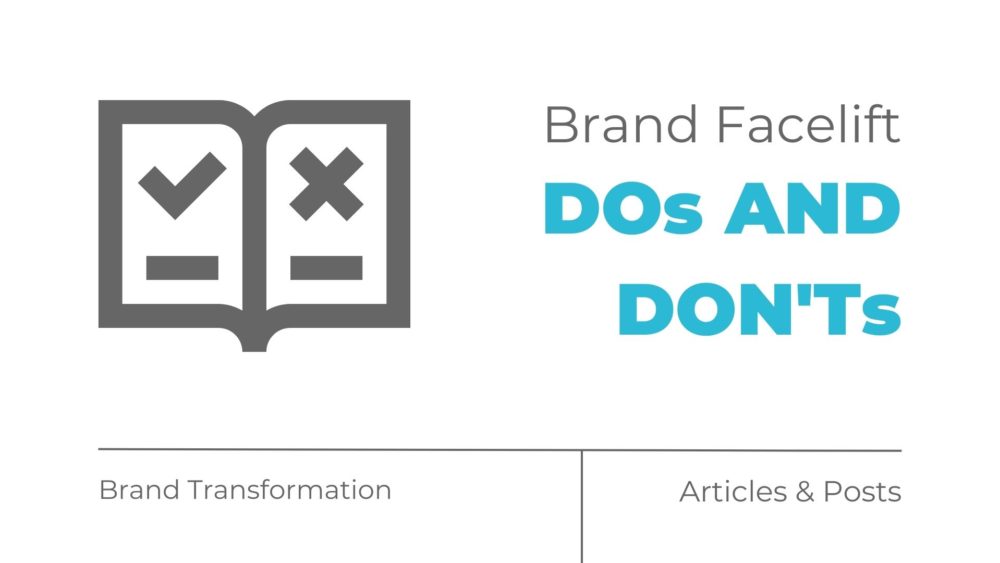Giving your brand a facelift is a little bit different than a rebrand.
A brand facelift involves making subtle updates to the existing brand elements rather than completely transforming them like you would in a full rebranding.
To do it will, pay attention to brand facelift dos and don’ts, and make sure you’re following best practices for a successful facelift.
These include doing the necessary research and planning before you act, and remembering NOT to rush the process or make really big changes.
What is a Brand Facelift?
A brand facelift is a process of updating a company’s branding elements, such as logo, color scheme, typography, and messaging, to give it a fresh look and feel without changing its core identity.
This approach helps businesses maintain their relevance in the market and appeal to new customers while retaining their existing customer base.
A well-executed brand facelift can enhance brand recognition, create a stronger emotional connection with customers, and improve overall business performance.
It has a lower risk than rebranding, also.
However, a brand facelift should never be taken lightly, and it’s important to follow some dos and don’ts to ensure success.
DOs of a Brand Facelift
1. DO Conduct Thorough Research
Before embarking on a brand facelift, gather insights about your:
- target audience
- competitors
- and industry trends.
Don’t assume you already know.
This is an important step and will help you make informed decisions about the changes required and ensure that any changes you make align with your customers’ expectations and preferences.
2. DO Involve Your Team
Your employees are the face of your brand.
They play a critical role in delivering the brand experience to customers.
Involving them in the facelift process ensures that they understand the reasons behind the change and can effectively communicate the facelift to customers.
3. DO Test Your New Brand Elements
Before launching your updated brand elements, test them with a small group of customers or stakeholders to gather feedback and gauge their reactions.
This will help you identify any potential issues or areas for improvement before rolling out the changes to a larger audience.
4. DO Create a Timeline and Budget
Numbers matter and you need to pay attention to them.
Develop a realistic timeline and budget for your brand facelift, considering factors like design and development, marketing materials, employee training, and communication efforts.
This will help you stay organized and ensure a smooth transition.
DON’TS of a Brand Facelift
Knowing what to avoid is just as important as knowing what to do.
1. DON’T Change Your Brand Identity Drastically
A brand facelift should be a subtle evolution of your existing brand identity, not a complete overhaul.
Avoid making drastic graphic design or brand personality changes that could alienate your existing customers and create confusion in the market.
2. DON’T Neglect Your Core Values
While updating your brand elements, it’s essential to stay true to your company’s core values and mission.
Ensure that the changes you make align with your brand’s essence and do not dilute its identity.
3. DON’T Rush the Process
It’s like Atlanta traffic: rushing the process can hurt you more than help you.
A successful brand facelift takes time and careful planning.
Resist the urge to rush the process and ensure that you allocate enough time for research, design, testing, and communication.
Getting all your ducks in a row takes time, but it pays off to have everything synchronized.
4. DON’T Overlook the Importance of Communication
Communication is critical during a brand facelift.
Not communicating effectively can really be a pitfall that hurts your brand.
Ensure that you keep your employees, customers, and stakeholders informed about the changes and the reasons behind them to maintain trust and support throughout the transition.
In this situation, everyone does not love surprises.
At the End of the Day
At the heart of a successful brand facelift lies thoughtful planning, appropriate research, and consistent communication.
It’s about subtly evolving your brand, not drastically altering it.
You need to retain the core values that your customers identify with.
Remember, while refreshing your brand may bring an invigorating change, it should always resonate with your existing brand identity and audience’s expectations.
By following these dos and don’ts, you can ensure that your brand facelift enhances your market presence, elevates customer connection, and drives your business forward.


Comments are closed.